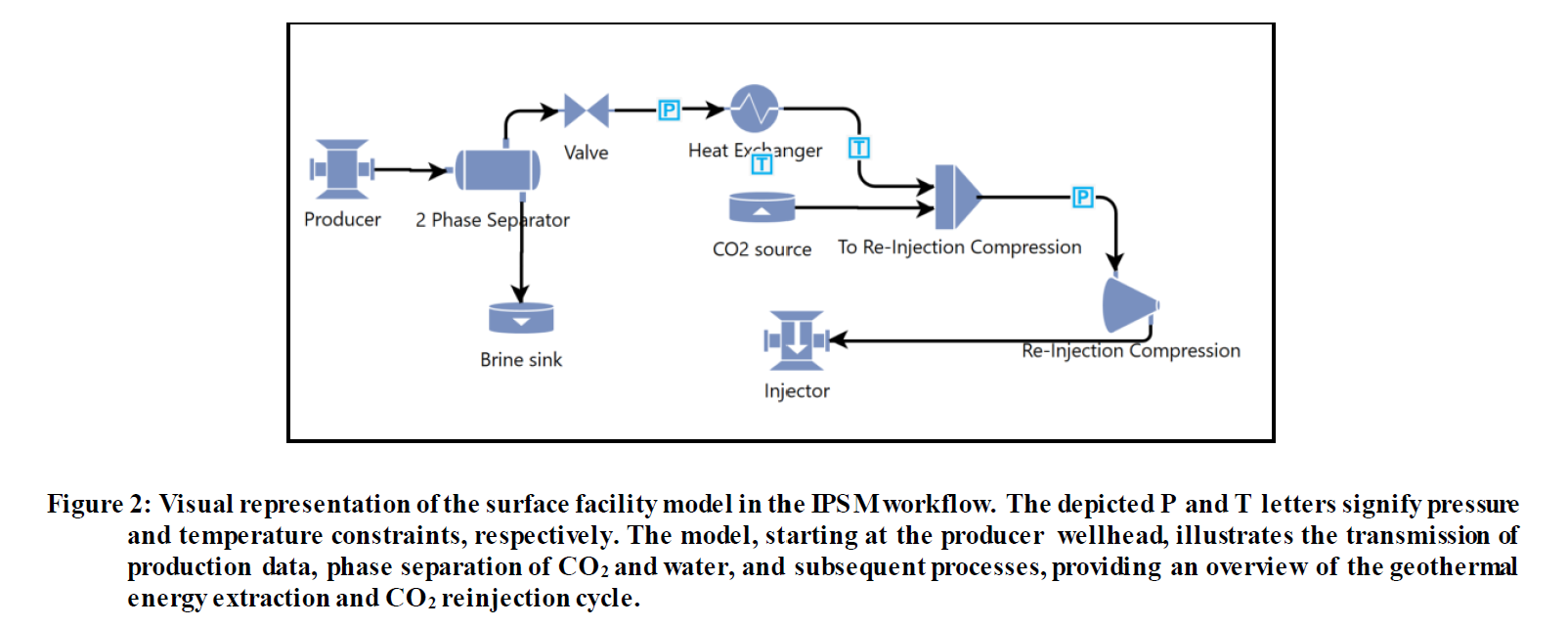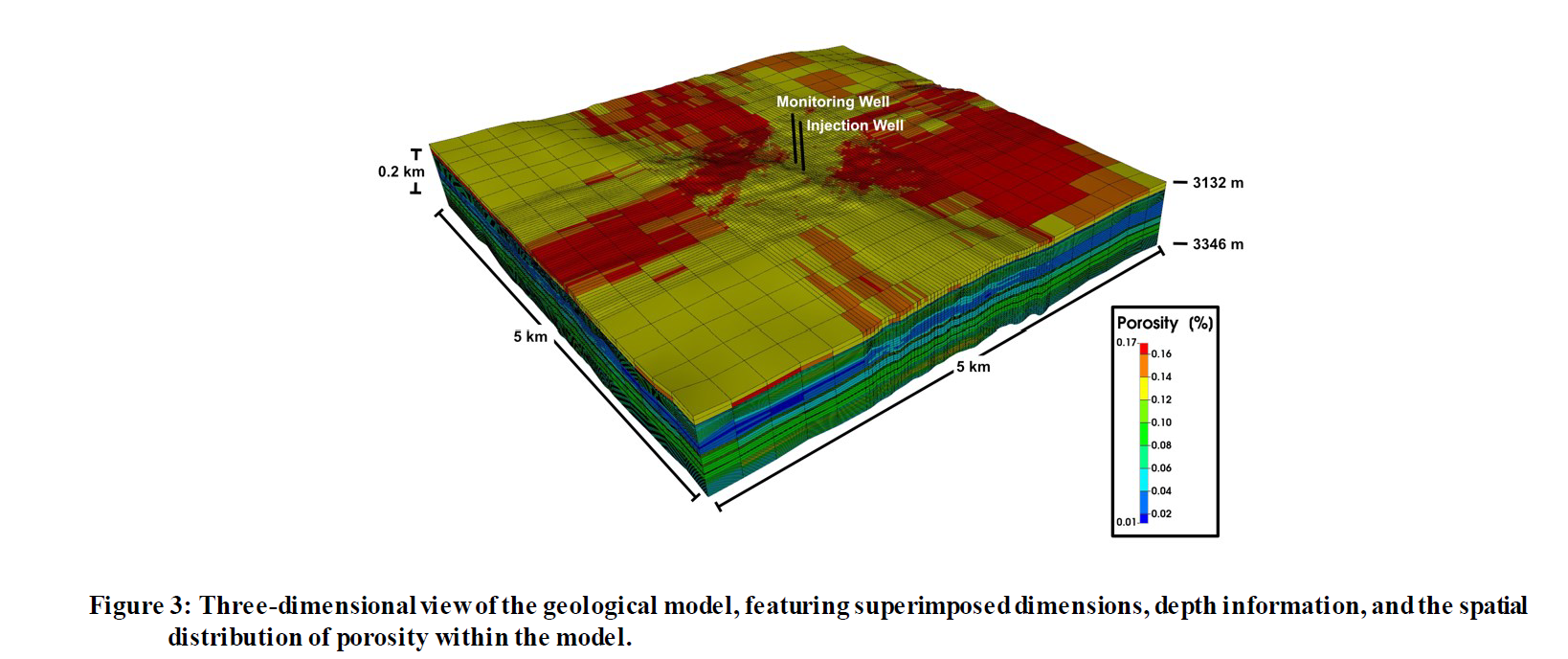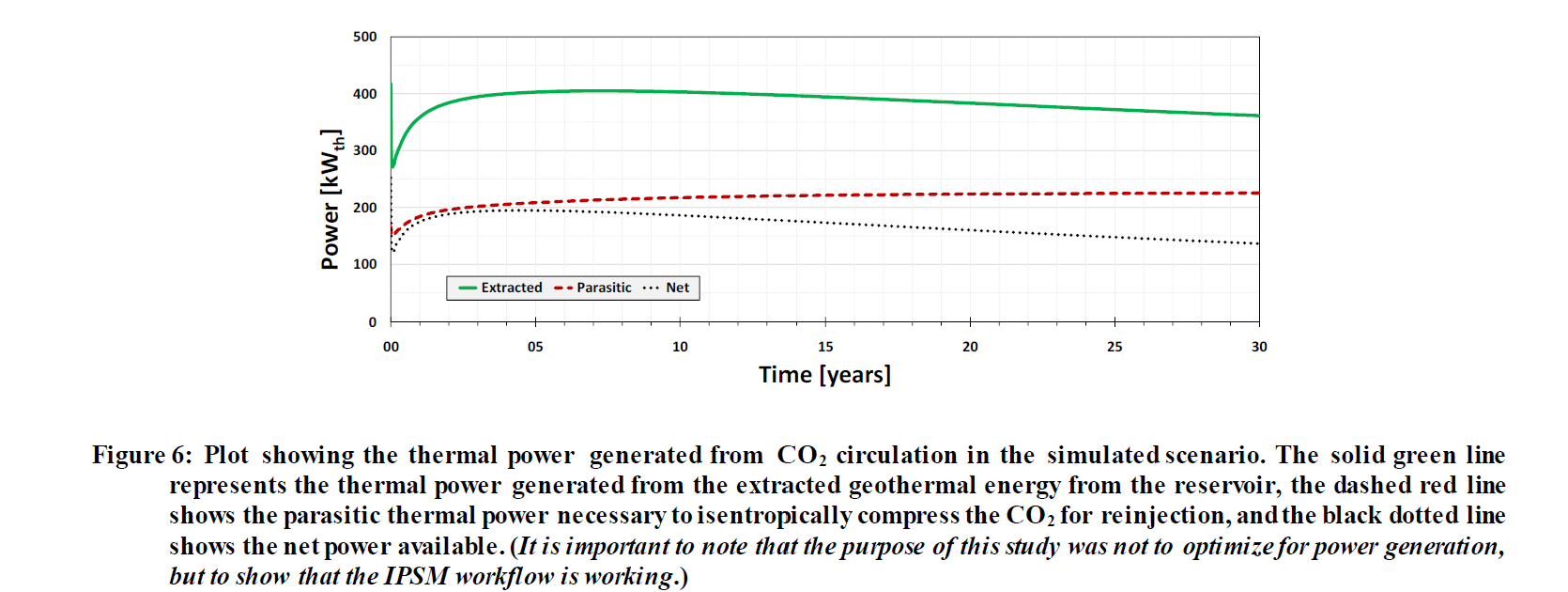Development of an Integrated Reservoir and Production System Modelling (IPSM) Workflow for simulating CO2-Plume Geothermal (CPG) Systems at the Aquistore CCS Site
1. 研究背景与目标
文件描述了CMG软件在加拿大Aquistore CCS(碳捕集与封存)站点进行CPG系统模拟的应用。CPG系统使用超临界CO2作为地热工作流体,通过将其注入并在封闭系统中循环,从油藏到地表提取地热能。这种方法可以提高CCS系统的经济效益,同时减少地层温度和压力,从而增加CO2的封存容量和安全性。
2. CMG软件的应用
- 油藏模型建立:使用CMG的GEM(组分模型)软件,结合地质和地球物理数据,如井轨迹、测井、岩心和解释的地震测线,构建了一个5 km x 5 km的地质模型。模型考虑了岩石的孔隙度和渗透率分布,以及油藏的初始条件,如压力和温度。
- 流体流动模拟:GEM软件用于模拟地层中的瞬态流体流动,采用Peng-Robinson方程来描述CO2和盐水组分在不同相之间的分配。CO2在盐水中的溶解度使用Harvey相关性进行建模,并考虑了盐度的修正。
- 井筒和地面设施模拟:CoFlow软件用于模拟井筒和地面设施,包括压力降、相分离和热交换过程。这使得可以将地层、井筒和地面设施的动态相互作用集成到CPG循环中。
- 集成生产系统建模(IPSM):通过将水层模型与井筒/设施模拟器集成,开发了一个IPSM工作流程,能够模拟CPG系统的完整循环,包括地热能提取、CO2再注入以及能量转换。
3. 模拟结果
- 流体循环:模拟结果显示,在CPG系统启动阶段,生产井的总流体产量(CO2 + 水)会急剧下降,随后逐渐增加并稳定在一个较稳定的水平。
- 温度和压力分布:生产井的温度随时间线性下降,而压力在模拟期间保持相对稳定。
- 热能生成:模拟表明,从地热能提取中产生的热能大于再注入CO2所需的寄生热能,从而提供了正的净热能。
4. 结论与展望
CMG软件的应用成功地展示了IPSM工作流程在模拟CPG系统方面的有效性。通过这种集成方法,研究人员能够更好地理解流体组成、油藏条件和质量流量之间的动态相互作用,并识别出高效可持续的地热能提取实践。未来的研究将致力于进一步优化模型,包括考虑地表管道和设备中的压力和温度损失,以及提高模型的复杂性,以更好地模拟实际生产条件。
通过这项研究,CMG软件证明了其在模拟复杂的地热能提取和CO2封存系统方面的强大能力,为能源转型和减碳提供了有力的技术支持。
ABSTRACT
A strong reduction in global carbon dioxide (CO2) emissions is necessary to achieve the climate targets set out in the Paris Agreement. Decarbonisation of the energy sector, for example, requires baseload renewable energy sources, while decarbonisation of the cement and other heavy industries requires active capture and permanent (geologic) sequestration of CO2 (e.g. carbon, capture, and storage (CCS)). So far, economic constraints prevent the commercial-scale deployment of the CCS technology. Geothermal energy, as one of the renewable energy sources, can provide significant baseload energy supply but is restricted to regions with high (a) geothermal gradients and (b) rock transmissivities. Often, one of these is not given, limiting economic geothermal energy extraction.
The usage of supercritical CO2 as a geothermal working fluid by injecting it and circulating it in a closed system from the reservoir to the Earth’s surface to extract the geothermal energy can open possibilities in regions that are otherwise economically disadvantageous for geothermal energy use. Previous studies have shown that the theoretical efficiency of a geothermal system can be doubled to tripled, compared to conventional geothermal systems, due to the significantly lower kinematic viscosity of supercritical CO2, compared to H2O. This concept is commonly known as CO2-Plume Geothermal (CPG). It uses (eventually) permanently sequestered CO2 from a CCS site to a) improve the business case of CCS systems by generating geothermal power (thermal and/or electric) and b) reduce the reservoir temperature and pressure, which in turn increases the overall CO2 storage capacity and safety.
In our numerical feasibility study, we investigate the suitability of the active, commercial-scale, research-oriented Aquistore CCS site in Canada for a CO2-circulation demonstration test. We apply a pioneering workflow, combining (1) a field history-matched, heterogeneous reservoir model with (2) a full-physics fluid flow simulator, (3) a wellbore and (4) a simplified surface facility model (representing surface energy extraction and CO2 reinjection) in an integrated manner.



